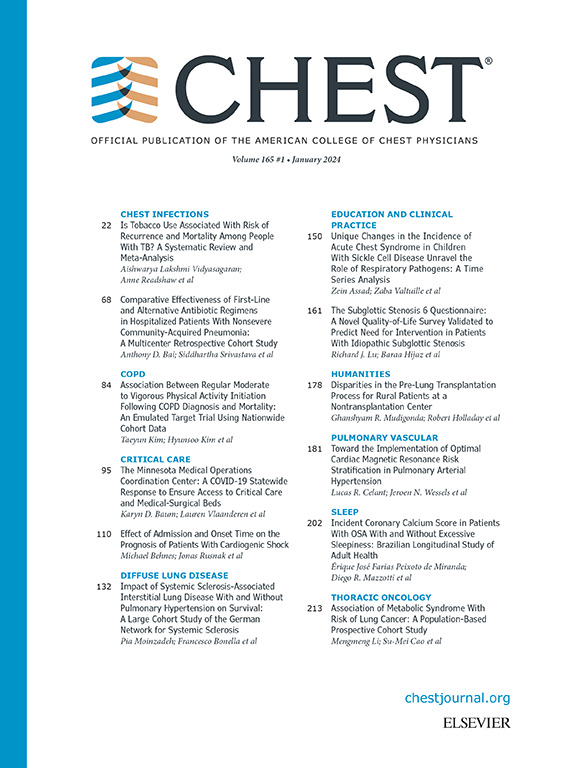XALOC-1: Clinical remission over 2-years with benralizumab in severe eosinophilic asthma.
IF 9.5
1区 医学
Q1 CRITICAL CARE MEDICINE
引用次数: 0
Abstract
BACKGROUND Long-term real-world data on clinical remission in patients with severe eosinophilic asthma (SEA) receiving biologics are lacking. We describe clinical remission over 2 years in patients with SEA receiving benralizumab. RESEARCH QUESTION Is long-term clinical remission a viable goal for patients with SEA receiving benralizumab? STUDY DESIGN AND METHODS XALOC-1 is a multinational, retrospective, real-world program in adults with SEA who received benralizumab for ≤96 weeks. Percentages of patients meeting the components and composite of clinical remission (no exacerbations, no maintenance oral corticosteroid [mOCS] use, and well-controlled asthma [Asthma Control Test score ≥20 or 6-item Asthma Control Questionnaire score ≤0.75 ]) were assessed at Weeks 0, 48, and 96. The association between key baseline demographics, clinical characteristics, and clinical remission status was assessed at Weeks 48 and 96 using multivariable logistic regression analysis. RESULTS Of 1070 patients, 0.4%, 39%, and 31% met the 3-component clinical remission criteria at Weeks 0, 48, and 96, respectively. In biologic-naïve and biologic-experienced patients, remission occurred in 43% and 32% (Week 48), and 36% and 23% (Week 96) of patients, respectively. Lower mOCS dose (odds ratio [95% confidence interval] 0.51 [0.34, 0.76]), lower body mass index (0.56 [0.36, 0.86]), and higher peak eosinophil count (1.68 [1.05, 2.69]) at baseline were positively associated with meeting criteria for clinical remission at Week 96. INTERPRETATION Clinical remission is a realistic goal, sustainable up to 2 years in around one-third of patients with SEA receiving benralizumab. Remission was more likely in patients with lower baseline disease burden, suggesting that further research is warranted regarding whether earlier initiation of a biologic may be beneficial.XALOC-1: benralizumab治疗严重嗜酸性哮喘2年以上临床缓解。
背景缺乏关于接受生物制剂治疗的严重嗜酸性粒细胞性哮喘(SEA)患者临床缓解的长期真实数据。我们描述了接受苯拉利珠单抗治疗的嗜酸性粒细胞性哮喘(SEA)患者 2 年来的临床缓解情况。研究问题对于接受苯拉利珠单抗治疗的嗜酸性粒细胞性哮喘(SEA)患者来说,长期临床缓解是否是一个可行的目标?在第 0 周、第 48 周和第 96 周评估了符合临床缓解的组成要素和复合要素(无病情加重、不使用维持性口服皮质类固醇 [mOCS]、哮喘控制良好 [哮喘控制测试评分≥20 分或 6 项哮喘控制问卷评分≤0.75])的患者百分比。结果 在1070例患者中,分别有0.4%、39%和31%的患者在第0、48和96周达到了3项临床缓解标准。在无生物制剂治疗经验和有生物制剂治疗经验的患者中,分别有43%和32%的患者(第48周)和36%和23%的患者(第96周)出现缓解。基线时较低的 mOCS 剂量(几率比 [95% 置信区间] 0.51 [0.34,0.76])、较低的体重指数(0.56 [0.36,0.86])和较高的嗜酸性粒细胞峰值计数(1.68 [1.05,2.69])与第 96 周时达到临床缓解标准呈正相关。基线疾病负担较轻的患者更有可能获得缓解,这表明有必要进一步研究较早开始使用生物制剂是否有益。
本文章由计算机程序翻译,如有差异,请以英文原文为准。
求助全文
约1分钟内获得全文
求助全文
来源期刊

Chest
医学-呼吸系统
CiteScore
13.70
自引率
3.10%
发文量
3369
审稿时长
15 days
期刊介绍:
At CHEST, our mission is to revolutionize patient care through the collaboration of multidisciplinary clinicians in the fields of pulmonary, critical care, and sleep medicine. We achieve this by publishing cutting-edge clinical research that addresses current challenges and brings forth future advancements. To enhance understanding in a rapidly evolving field, CHEST also features review articles, commentaries, and facilitates discussions on emerging controversies. We place great emphasis on scientific rigor, employing a rigorous peer review process, and ensuring all accepted content is published online within two weeks.
 求助内容:
求助内容: 应助结果提醒方式:
应助结果提醒方式:


